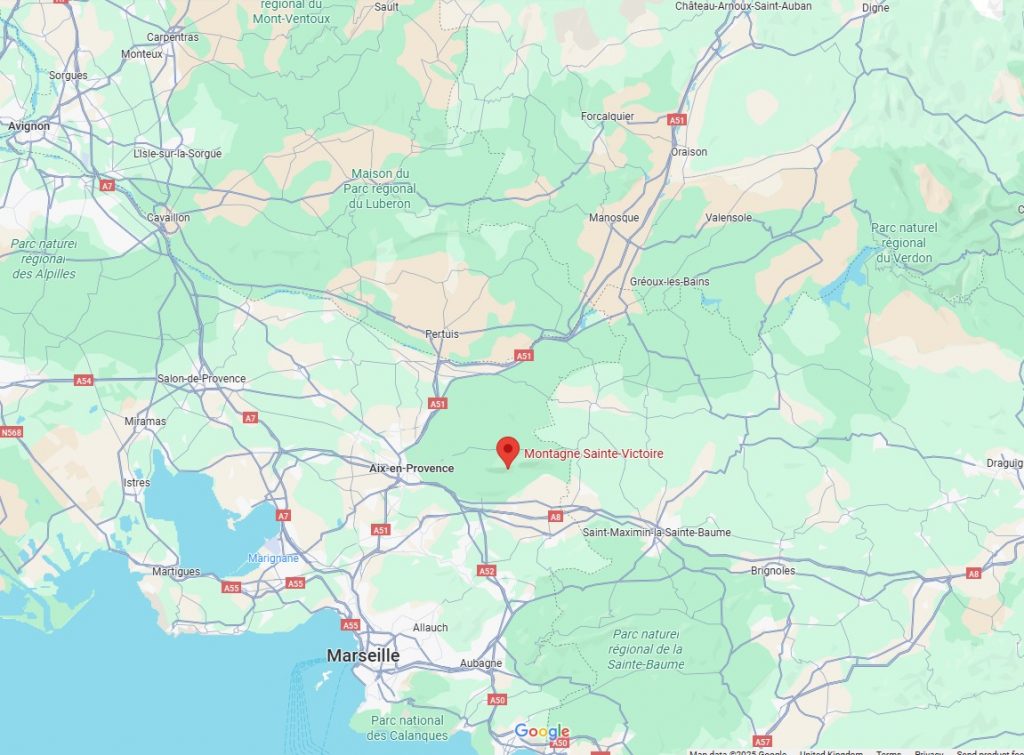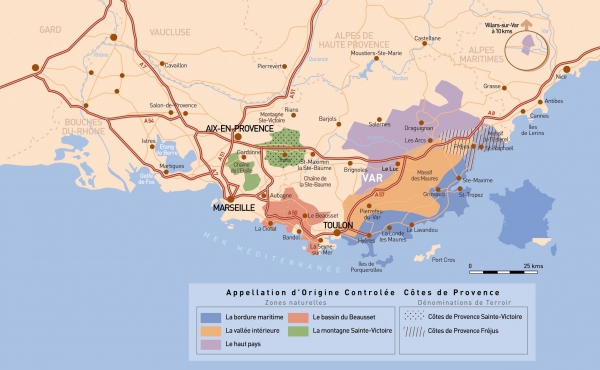Rising dramatically above the Provençal landscape, Mont Sainte-Victoire has inspired painters, poets, and travellers for centuries. Its pale limestone slopes, immortalised by Paul Cézanne, are more than an iconic vista—they are the cradle of a unique terroir that has earned its place among the most celebrated wine-growing zones in southern France. Sainte-Victoire’s journey from a geographic name to an officially recognised cru within the Côtes de Provence appellation is a story of passion, perseverance, and the power of place.

History of the Appellation
The recognition of Sainte-Victoire as a distinct cru is a relatively recent chapter in Provence’s long viticultural history, but its roots run deep. Wine has been made in this part of the Var and Bouches-du-Rhône for over 2,600 years, dating back to the Phoenicians and later the Romans, who recognised the region’s rocky soils and sun-drenched slopes as ideal for vines. In the modern era, Sainte-Victoire was for decades a subzone within the broad Côtes de Provence appellation, producing wines known for freshness and elegance rather than sheer power. It was the late 20th century, however, that saw a coalition of producers push for recognition of the area’s singularity. In 2005, the designation “Côtes de Provence Sainte-Victoire” was formally established, granting the wines the status of a named geographical denomination within the AOC system. Stricter yield controls, grape variety requirements, and winemaking regulations set the stage for a leap in quality and a more defined identity. This was not simply a bureaucratic upgrade—it was the culmination of decades of work by growers committed to showing the world that Sainte-Victoire’s wines deserved their own place on the map.

The People
Behind Sainte-Victoire’s rise are the people who farm its vineyards and interpret its terroir. Many are multigenerational families whose roots here go back centuries, such as the Sumeire family at Château Coussin, who have been tending Provençal vines since the 13th century. Others are newcomers drawn by the mountain’s beauty and the region’s potential, bringing fresh ideas and an international outlook. These winemakers share a common philosophy: a respect for the land, a belief in low yields to ensure concentration, and a commitment to crafting wines that balance Mediterranean generosity with the mineral precision that the limestone soils impart. Increasingly, sustainable and organic practices are the norm rather than the exception, with estates adopting cover crops, limiting chemical inputs, and preserving biodiversity in and around the vineyards. The collective effort of these producers—whether rooted in centuries of tradition or guided by new-wave experimentation—has forged the Sainte-Victoire style we know today.
Vineyards & Terroir
Sainte-Victoire’s vineyards stretch across a mosaic of parcels at the foot of the eponymous mountain, between the towns of Trets, Puyloubier, and Pourrières. The soils here are dominated by limestone scree and clay-limestone mixtures, interspersed with patches of red clay and pebbly alluvium. These stony, well-drained sites force the vines to send roots deep in search of water, resulting in smaller yields but grapes of great concentration. The climate is classically Mediterranean, with abundant sunshine and the cleansing influence of the mistral wind, which keeps vines healthy and reduces disease pressure. Crucially, the elevation—often between 200 and 500 metres—introduces cooler nights, allowing for slow, even ripening and the preservation of acidity. This combination of geology, topography, and climate gives Sainte-Victoire wines their hallmark tension: ripe Provençal fruit framed by freshness and an underlying mineral backbone.
Wine Portfolio
The wines of Sainte-Victoire are most famous for their rosés, which are pale in colour yet deep in character. Crafted predominantly from Grenache, Syrah, Cinsault, and Mourvèdre, these rosés offer aromas of wild strawberry, white peach, citrus zest, and sometimes the herbal garrigue scents of thyme and rosemary. On the palate, they are textured yet lively, with a saline edge that speaks of limestone soils. Red wines, though produced in smaller volumes, are equally compelling—structured blends of Syrah and Grenache often accented by Mourvèdre, offering black cherry, violet, and spice notes with fine-grained tannins. White wines are rare but striking, typically from Rolle (Vermentino) and Clairette, showing citrus blossom, almond, and a stony finish. Many producers favour gentle pressing, cold fermentation for whites and rosés to preserve aromatics, and careful extraction for reds to ensure balance rather than brute force. Oak is used judiciously, particularly for reds, adding texture without masking the purity of fruit.
Five Notable Wineries
Close to the heart of the Sainte-Victoire cru, a cluster of remarkable wineries reinforces the area’s reputation. Château Gassier, located at the foot of the mountain, combines traditional methods with cutting-edge technology to produce crystalline rosés, their “Esprit Gassier” and “946” cuvée showcasing both elegance and terroir expression. Château Coussin, part of the Sumeire family holdings, is a benchmark estate with a long heritage, crafting refined rosés and structured reds that speak to the family’s centuries of winemaking experience. Domaine des Masques, high on the plateau, benefits from cooler conditions and focuses on precision, producing both rosés and reds with pronounced freshness and aromatic lift. Mas de Cadenet, one of the oldest estates in the region, dates back to 1813 and has been certified organic for years, offering vibrant wines that highlight biodiversity-friendly farming. Finally, Domaine Terre de Mistral marries viticulture with gastronomy, operating an estate restaurant alongside its winery, and crafting expressive rosés and reds that capture the warmth and charm of Provence.
The Road Ahead: Sainte-Victoire’s Near and Long-Term Future
The elevation of Sainte-Victoire to cru status was never the final chapter—it was a foundation for what comes next. In the near future, the focus will be on refining the appellation’s identity in the global marketplace. Provençal rosé has already captured the imagination of consumers worldwide, but Sainte-Victoire producers are increasingly determined to distinguish their wines not just by their pale hue, but by the elegance, structure, and mineral drive that the limestone terroir imparts. Expect to see more single-vineyard bottlings, limited releases, and cuvées that explore the nuances of microclimates within the cru. Organic and biodynamic certifications are set to become more prevalent, with many estates already transitioning toward regenerative farming methods that build soil health and resilience against climate change.
The medium-term horizon will likely bring increased investment, both from established Provençal families and from international buyers attracted by the prestige of the cru. This could mean upgraded cellars, more precise vineyard mapping, and experimentation with new grape varieties within the rules of the AOC to adapt to shifting weather patterns. Climate resilience will be central to this evolution—rising summer temperatures and irregular rainfall will challenge producers to manage ripening without losing the signature freshness that defines Sainte-Victoire wines. Some are already trialling drought-tolerant rootstocks, adjusting canopy management, and experimenting with earlier harvests to protect acidity.
In the longer view—twenty years and beyond—Sainte-Victoire has the potential to stand alongside the great terroirs of southern France in the minds of wine professionals. Its reputation will be built not only on its rosés, but on reds and whites that are currently produced in small quantities but could emerge as hidden treasures. If the cru continues to combine strict quality standards with a willingness to innovate, it will likely become a reference point for terroir-driven Provençal wine, much as Châteauneuf-du-Pape defines the southern Rhône. Tourism will play an important role as well; the scenic draw of Mont Sainte-Victoire, combined with a rising network of cellar doors, gastronomic restaurants, and boutique accommodations, will create a deeper connection between visitors and the wines. This human connection—sharing a glass at the foot of Cézanne’s mountain—will ensure that Sainte-Victoire is not just a name on a label, but a living, evolving story.